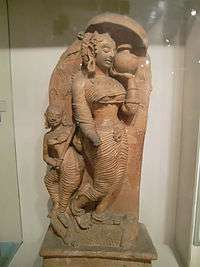River deities in Hinduism
In Hinduism, rivers are often regarded as deities. This is because of their significance in the people's lives. In the Rigveda, there are mentions of holy rivers including Saraswati. The river Ganga is considered to be most sacred. Most of the rivers are represented in female form.[1] However, Brahmaputra is considered to be male.[2] It is also believed that the Indus Valley people worshipped the rivers.[3] The most significant rivers are the Saptanadi : Ganga, Yamuna, Sindu, Narmada, Godavari, Krishna, and the Kaveri.
Goddesses
Ganga

The Vedas and Puranas mention Ganges to be most sacred river. In the legends, goddess Ganga is daughter of Himavan (Himalayas) and Menavati (An apasara). She is the sister of Mother goddess, Parvati. She is the goddess of Purity and Purification as people believe bathing in Ganges removes sins and helps in gaining Moksha. Her mouth is Makara.
Legends also mention that she came down from the heaven. Bhagiratha (an ancestor of Shri Rama) performed a penance to please mother Ganga. He asked her to come down from heaven to liberate his ancestors' spirits. She agreed but also told that are force would destroy the Earth if she directly hits it. Bhagiratha then, asked Lord Shiva to help. Shiva agreed to stand between the Earth and Ganga. Ganga, then came down to earth with her full force. Lord Shiva captured her in his hair and released her gently. Bhagiratha then took her to his ancestors' spirits and later, the ocean.[4]
Yamuna
Yamuna or Yami is the personification of the Yamuna river. She is daughter of Surya, the sun god, and Saranyu, the cloud goddess. She is the goddess of life and the twin of Yama, lord of dead. Her siblings include Tapati, another river goddess. In later texts, she is known as Kalindi.
Saraswati
The goddess Saraswati is not just a river goddess, but also one of the principle goddesses in Hinduism. She is the goddess of knowledge, music, speech and arts. The Saraswati river is mentioned in the Rigveda. It is believed that the river dried up.
In some texts, it is written that once there was a terrible battle between the Bhargavas and Hehayas, and from this an all-consuming fire called Vadavagni was born which could destroy the whole world. The devas were worried and they went to Shiva. Shiva suggested that they should go to Saraswati for help as she can become a river and immerse the Vadavagni in the ocean. All the devas and devis went to Saraswati and requested her to protect the universe. They all went to Bramha and he told Saraswati to become a river. Saraswati agreed and left Brahmaloka and arrived at sage Uttanka's ashram. There she met Shiva. He gave the Vadavagni in a pot to Saraswati and told her to originate from Plaksha tree. Saraswati merged with the tree and transformed into a river. From there she flowed towards Pushkar, which is a sacred place. She continued her journey towards the ocean. At last, she reached the end of her journey and immersed the fire in the ocean.[5]
Narmada
Devi Narmada is the personification of the Narmada river. She is also known as Rewa. She is one of Lord Shiva's daughters. Once, Shiva was meditating. His sweat accumulated and Narmada was born.
She was very beautiful. Gods and demons wanted to marry her. Shiva arranged her wedding with the sea god.
References
- "River Goddesses | Mahavidya".
- "Being bold for change: Women's voices from the Brahmaputra River". March 29, 2017.
- "Symbolism of River in Hinduism". www.hinduwebsite.com.
- Seshadri, Lakshmi. Pai, Anant (ed.). Ganga. Amar Chitra Katha private limited. ISBN 81-89999-36-2.
- Kapur, Sanjana. Saraswati. Amar Chitra Katha Private limited. pp. 8–22. ISBN 978-93-5085-120-3.